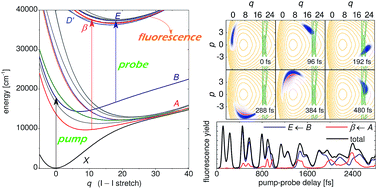Time-resolved spectra of I2 in a krypton crystal by G-MCTDH simulations: nonadiabatic dynamics, dissipation and environment driven decoherence†
Abstract
The multi-state photodynamics following the B 3Πu(0+) ← X 1Σ+g excitation of molecular iodine in a krypton crystal are studied quantum mechanically using the Gaussian variant of the multiconfigurational time-dependent Hartree method (G-MCTDH). Calculations are performed using a 9-state 18-dimensional Hamiltonian parametrized via diatomics-in-molecules calculations. The simulations reproduce the low predissociation yield deduced by time resolved spectroscopic experiments, and allow the elucidation of the diabatic population dynamics in the dense manifold of covalent electronic states of the embedded I2. The wave packet dynamics are used to calculate pump–probe spectra involving excited state absorption which terminates in the ion pair manifold. The simulated signals are in excellent agreement with the experimental ones, and are interpreted by reducing the full-dimensional wavefunction to the density matrix of the I2 subsystem. It is proved formally that the pump–probe traces can be obtained as convolution between the Wigner function of the chromophore and a time- and frequency-gate function also represented in the phase space. The analysis of the spectra with probe frequency in resonance with the β ← A 3Πu transition reveals that the mechanism of predissociation out of the B state is pump photon energy-dependent. The quantum nature of the nonradiative transitions is imprinted in the strongly non-classical features of the Wigner function on the A state surface, which is detected in the pump–probe process.

- This article is part of the themed collection: Quantum effects in complex systems


 Please wait while we load your content...
Please wait while we load your content...